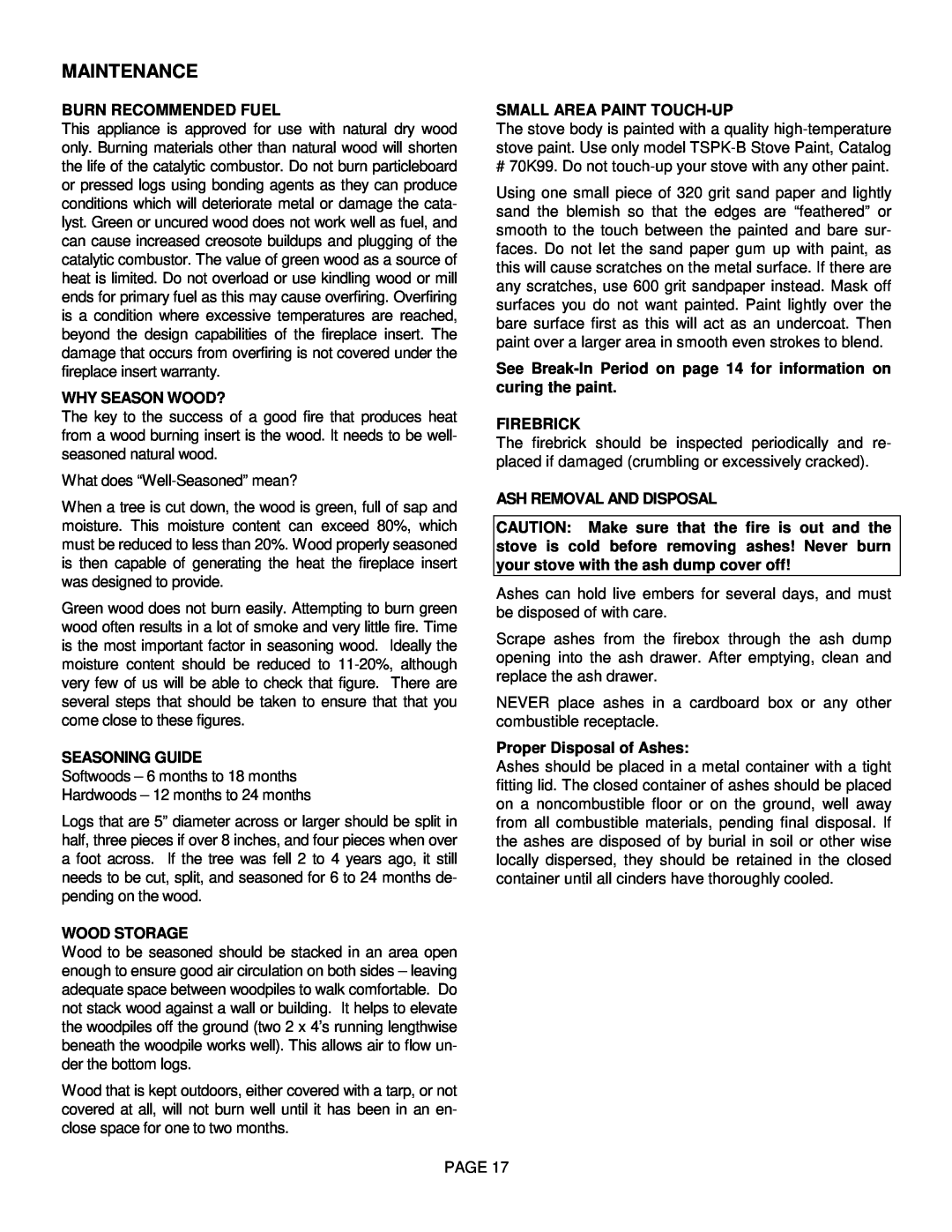
MAINTENANCE
BURN RECOMMENDED FUEL
This appliance is approved for use with natural dry wood only. Burning materials other than natural wood will shorten the life of the catalytic combustor. Do not burn particleboard or pressed logs using bonding agents as they can produce conditions which will deteriorate metal or damage the cata- lyst. Green or uncured wood does not work well as fuel, and can cause increased creosote buildups and plugging of the catalytic combustor. The value of green wood as a source of heat is limited. Do not overload or use kindling wood or mill ends for primary fuel as this may cause overfiring. Overfiring is a condition where excessive temperatures are reached, beyond the design capabilities of the fireplace insert. The damage that occurs from overfiring is not covered under the fireplace insert warranty.
WHY SEASON WOOD?
The key to the success of a good fire that produces heat from a wood burning insert is the wood. It needs to be well- seasoned natural wood.
What does
When a tree is cut down, the wood is green, full of sap and moisture. This moisture content can exceed 80%, which must be reduced to less than 20%. Wood properly seasoned is then capable of generating the heat the fireplace insert was designed to provide.
Green wood does not burn easily. Attempting to burn green wood often results in a lot of smoke and very little fire. Time is the most important factor in seasoning wood. Ideally the moisture content should be reduced to
SEASONING GUIDE
Softwoods – 6 months to 18 months Hardwoods – 12 months to 24 months
Logs that are 5” diameter across or larger should be split in half, three pieces if over 8 inches, and four pieces when over a foot across. If the tree was fell 2 to 4 years ago, it still needs to be cut, split, and seasoned for 6 to 24 months de- pending on the wood.
WOOD STORAGE
Wood to be seasoned should be stacked in an area open enough to ensure good air circulation on both sides – leaving adequate space between woodpiles to walk comfortable. Do not stack wood against a wall or building. It helps to elevate the woodpiles off the ground (two 2 x 4’s running lengthwise beneath the woodpile works well). This allows air to flow un- der the bottom logs.
Wood that is kept outdoors, either covered with a tarp, or not covered at all, will not burn well until it has been in an en- close space for one to two months.
SMALL AREA PAINT TOUCH-UP
The stove body is painted with a quality
# 70K99. Do not
Using one small piece of 320 grit sand paper and lightly sand the blemish so that the edges are “feathered” or smooth to the touch between the painted and bare sur- faces. Do not let the sand paper gum up with paint, as this will cause scratches on the metal surface. If there are any scratches, use 600 grit sandpaper instead. Mask off surfaces you do not want painted. Paint lightly over the bare surface first as this will act as an undercoat. Then paint over a larger area in smooth even strokes to blend.
See
FIREBRICK
The firebrick should be inspected periodically and re- placed if damaged (crumbling or excessively cracked).
ASH REMOVAL AND DISPOSAL
CAUTION: Make sure that the fire is out and the stove is cold before removing ashes! Never burn your stove with the ash dump cover off!
Ashes can hold live embers for several days, and must be disposed of with care.
Scrape ashes from the firebox through the ash dump opening into the ash drawer. After emptying, clean and replace the ash drawer.
NEVER place ashes in a cardboard box or any other combustible receptacle.
Proper Disposal of Ashes:
Ashes should be placed in a metal container with a tight fitting lid. The closed container of ashes should be placed on a noncombustible floor or on the ground, well away from all combustible materials, pending final disposal. If the ashes are disposed of by burial in soil or other wise locally dispersed, they should be retained in the closed container until all cinders have thoroughly cooled.
PAGE 17
